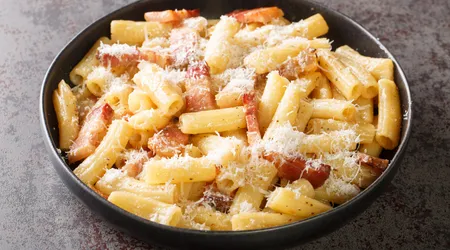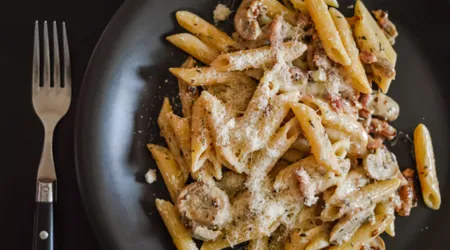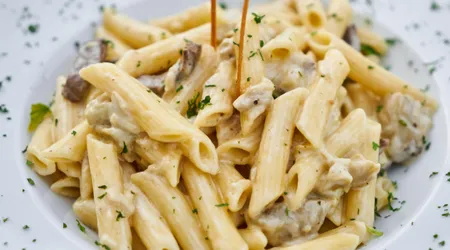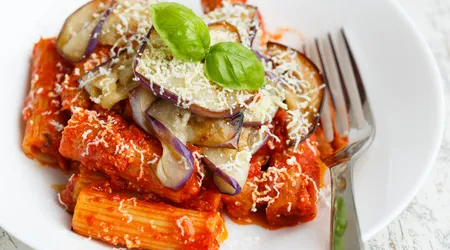Pasta alla Gricia: The Mother of Carbonara

There pasta alla gricia It's much more than just a traditional Roman dish: it's a pillar of Italian cuisine, a bridge between past and present, a symphony of essential flavors that gave rise to one of the most famous dishes in the world, carbonara.
Announcements
But what makes this dish so special?
Why, despite its simplicity, does it continue to conquer palates and be considered the "mother" of other iconic recipes?
In this article, we'll explore the history, preparation, and cultural significance of pasta alla gricia, with an approach that combines authenticity, creativity, and thoughtful insights.
++ Tuscan Pici with Garlic Sauce: A Masterpiece of Tuscan Cuisine
Announcements
Get ready to discover a dish that, despite its minimalist essence, tells a story rich in tradition and flavor.
The historical origins of pasta alla gricia

Pasta alla gricia originated in the Lazio countryside, in a rural setting where simplicity was a necessity and ingredients were locally available.
This dish, in fact, is based on basic ingredients such as guanciale, pecorino romano, and black pepper, products that the shepherds of the area could easily find.
Its origins are linked to transhumance, the seasonal movement of flocks, during which shepherds prepared quick but nutritious meals.
Gricia, in this sense, is an example of subsistence cooking, where each ingredient had a precise role: the bacon provided energy, the pecorino cheese flavor, and the pepper a note of warmth.
But what is the connection with carbonara?
Pasta alla gricia is often called its “mother” because it represents a primordial version, without the egg, which would later evolve into the modern carbonara.
It is as if the gricia were the raw canvas on which an artist then painted a more complex masterpiece.
Its history is intertwined with that of Amatrice, a city in Lazio famous for amatriciana, another “daughter” of gricia that adds tomato.
This trio of dishes—gricia, carbonara, and amatriciana—forms a sort of Roman culinary trinity, where each recipe evolves from the previous one while maintaining a distinct identity.
An interesting fact emerges from a study conducted by the Italian Academy of Cuisine: approximately 70% of Roman restaurants include pasta alla gricia on their menus, a testament to its centrality in the local gastronomic culture.
However, its origin remains shrouded in mystery, with some theories linking it to the village of Grisciano, a hamlet of Accumoli, while others see it as a tribute to the "grey" shepherds, those dressed in simple, dusty clothes.
Whatever the truth, gricia represents an intangible heritage that deserves to be celebrated.
The ingredients: the art of simplicity

The strength of pasta alla gricia lies in its simplicity.
With just four ingredients—pasta, guanciale, pecorino romano, and black pepper—this dish proves that the quality of the ingredients can transform a seemingly simple recipe into an extraordinary gastronomic experience.
++ Fusilli with Cream of Zucchini and Mint
Guanciale, for example, is not a simple substitute for pancetta: its fatty consistency and intense flavour, deriving from the curing of the pork cheek, are irreplaceable.
Using pancetta instead of guanciale would be like replacing a Stradivarius violin with a plastic instrument: the result could never be the same.
Pecorino Romano isn't just a cheese, but a symbol of Lazio's pastoral tradition. Its sharp flavor balances the richness of the guanciale, creating a perfect balance.
Black pepper, often overlooked, adds an aromatic dimension that enhances other flavors without overpowering them.
Finally, strictly durum wheat pasta, such as spaghetti, rigatoni, or mezze maniche, must be cooked al dente to maintain the structure needed to hold the sauce.
Each element is indispensable, and their combination requires precision and respect for tradition.
To understand the importance of ingredients, let's consider an original example.
Imagine a plate of gricia prepared in a trattoria in Trastevere, where the guanciale is cut into strips and slowly browned until crispy, while the pecorino is freshly grated on the spot.
++ Spaghetti alla Puttanesca: Traditional Recipe
Once drained, the pasta is mixed with the cooking water to create a thick, velvety cream.
This seemingly simple process requires a thorough understanding of timing and proportions, transforming humble ingredients into a dish that speaks directly to the heart.
Table:
| Ingredient | Role on the plate | Main feature |
|---|---|---|
| Jowls | It provides intense flavour and fatty consistency | Seasoned, derived from pork cheek |
| Pecorino Romano | Balances with savory and adds creaminess | DOP cheese, produced with sheep's milk |
| Black pepper | It gives warmth and aromatic notes | Freshly ground to enhance the flavor |
| Pasta | Structural base that absorbs the seasoning | Durum wheat, preferably rigatoni or spaghetti |
Preparation: technique and tradition

Making the perfect pasta alla gricia is a balancing act between technique and instinct.
The first rule is to respect the ingredients: guanciale, for example, should not be cooked in oil, as its natural fat is sufficient to create a tasty base.
Cutting it into strips about 2-3 mm thick ensures even browning, while a non-stick pan over medium-low heat allows the fat to render without burning.
This step is crucial: overcooked guanciale becomes dry, compromising the creaminess of the dish.
Another fundamental aspect is the management of the cooking water.
The starch released by the pasta during cooking is the secret to obtaining a thick, velvety sauce without adding cream, a mistake that would horrify any Roman.
After draining the pasta al dente, toss it in the pan with the guanciale, pecorino, and a ladle of cooking water.
The movement should be quick and decisive, almost like a conductor guiding the musicians towards perfect harmony. The pepper, added at the end, adds the final touch of liveliness.
Let's consider a second original example: a young cook, inspired by his Roman grandmother, decides to prepare gricia for a group of friends.
It uses artisanal rigatoni, guanciale from a small producer in Norcia, and 12-month-aged pecorino cheese.
Following tradition, he stirs the pasta directly in the pan, creating a sauce that envelops each rigatoni like a hug. The result?
A dish that brings diners together, evoking memories of Sunday lunches and family stories.
This proves that gricia is not just food, but an experience that connects people.
The Evolution: From Gricia to Carbonara
Why is pasta alla gricia considered the “mother” of carbonara?
The answer lies in its evolution. Gricia, with its combination of guanciale, pecorino, and pepper, is the foundation upon which carbonara is built, with the addition of egg for its characteristic creaminess.
It's as if gricia were a family tree, with carbonara as a branch that has developed in a new direction, enriched but faithful to its roots.
This evolution reflects the adaptability of Roman cuisine, capable of transforming simple ingredients into complex dishes without losing authenticity.
Carbonara, however, has not eclipsed gricia.
Indeed, the latter maintains a place of honor in Roman trattorias, appreciated for its purity.
The lack of egg makes it lighter but no less intense, a dish that challenges the chef to get the most out of a few ingredients.
Furthermore, gricia is more versatile: it can be prepared quickly, even in contexts where fresh eggs are not available, making it an ideal option for impromptu dinners or quick lunches.
A good analogy to understand this relationship is that of a book and its film adaptation.
La gricia is the original text, essential and profound; la carbonara is the film, enriched with special effects (the egg) but based on the same story.
Both have their own charm, but gricia retains a timeless elegance that makes it unique.
It's no coincidence that many Michelin-starred chefs, like those interviewed in a recent report by the Italian Academy of Cuisine, consider gricia a test of skill, as it doesn't allow for mistakes to be hidden behind additional ingredients.
The cultural importance and future of gricia
Pasta alla gricia is not just a dish, but a symbol of Roman culture, an expression of identity that resists globalization.
In an era dominated by fusion cuisines and modern reinterpretations, gricia represents a kind of gastronomic resistance, a call to simplicity and tradition.
Eating a plate of gricia in a Testaccio trattoria is an act of connection with the past, a way to honor the shepherds who, centuries ago, created this recipe with what they had available.
But gricia is not just a legacy of the past: its future is bright.
Thanks to its versatility and the growing interest in authentic cuisine, it is also gaining space on international menus.
Restaurants from New York to Tokyo include gricia as an alternative to carbonara, often touted as a discovery for foodies seeking authentic flavors.
This renewed interest demonstrates that simplicity can be a universal value, capable of speaking to different cultures without losing its essence.
And you, have you ever tasted pasta alla gricia prepared according to tradition?
This question isn't just an invitation to try the dish, but an exhortation to reflect on the importance of preserving the recipes that tell who we are.
Gricia, with its history and flavor, is a reminder that the true richness of cuisine lies in the ability to transform the ordinary into the extraordinary.
| I wait | Pasta alla Gricia | Bacon and egg |
|---|---|---|
| Main ingredients | Guanciale, pecorino, pepper, pasta | Guanciale, pecorino cheese, pepper, egg, pasta |
| Cream | Given by the starch in the cooking water | Made from egg and starch |
| Complexity | Essential, minimalist | More complex due to the addition of the egg |
| Preparation time | 15-20 minutes | 20-25 minutes |
Pasta alla gricia: Frequently Asked Questions
| Request | Answer |
|---|---|
| Can I use pancetta instead of guanciale? | No, the guanciale is essential for the authentic flavor. Pancetta has a different curing time and alters the result. |
| What type of pasta is best for gricia? | Rigatoni, spaghetti, or mezze maniche are ideal for their ability to hold the sauce. |
| Is it possible to make a vegetarian version of gricia? | Traditional gricia is based on guanciale, but alternatives like courgettes or mushrooms can be used for a creative version. |
| How much pecorino should I use? | About 30-40g per person, but adjust according to the taste and saltiness of the cheese. |
| Can I add cream to make the dish creamier? | Absolutely not: the creaminess comes from the cooking water and the pecorino cheese. The cream is a non-traditional addition. |
Pasta alla gricia: Conclusion
There pasta alla gricia It's much more than a dish: it's a journey through the history, culture, and flavors of Lazio.
Its simplicity is its strength, a reminder that authentic cuisine doesn't need artifice to shine.
As the mother of carbonara, gricia represents the roots of a tradition that continues to evolve, while maintaining its essence intact.
Whether you're a food enthusiast or simply curious, this dish deserves a place on your table and in your heart.
Try it, respect it and let yourself be won over by its timeless elegance.
